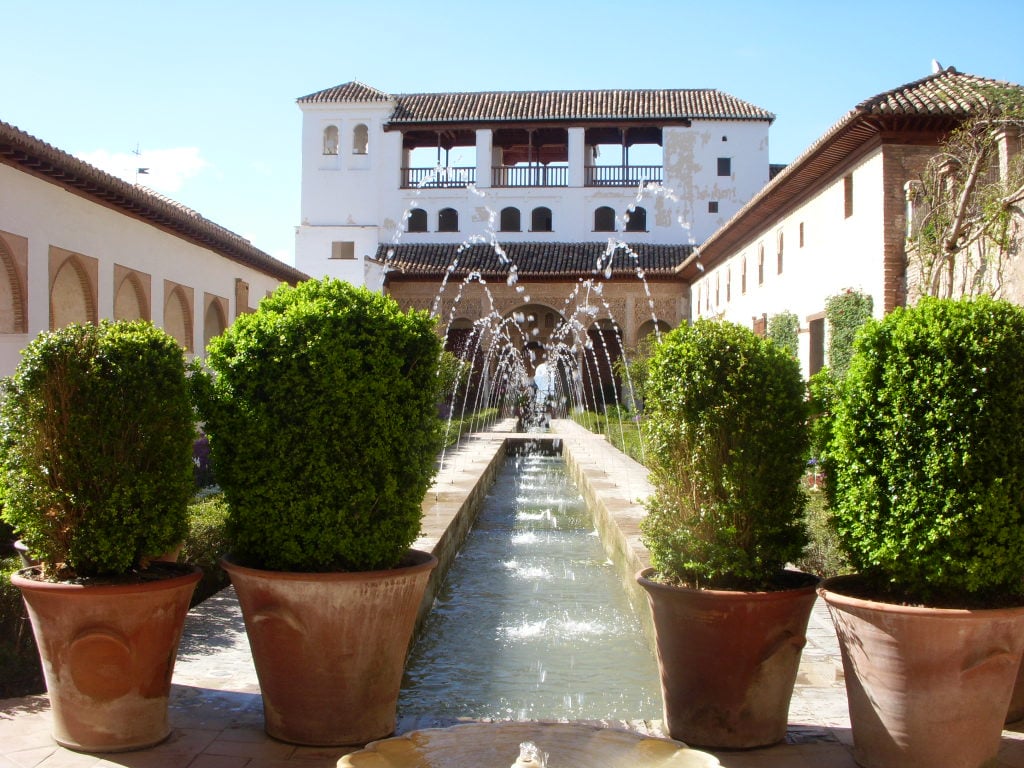

Contributor
- Topics: Archive, Inspired Gardens and Design

For millennia, humans have cultivated the landscape for food and enjoyment. Over the long course of history, many early garden management practices have been forgotten. Some of those ancient gardening methods can be effective today when we look to places with our shared ecology—places with the same conditions of water, light, and temperature.
Landscape design with integrated irrigation technology evolved with Muslim traditions and spiritual practices in ancient Persia. Islam spread into North Africa when the Umayyads (one of the original Muslim caliphates) converted the Moors beginning in the 8th century and from there moved into southern Spain. Islamic Spain (known as Al-Andalus or modern Andalusia) is a showcase for the evolution of a sophisticated use of water for both practical and aesthetic uses. The Spaniards later carried their gardening traditions to Mexico and into California, bringing knowledge of how to live in an arid climate to North America.
The Mediterranean climate of Andalusia, characterized by hot, dry summers, mild winters with variable rainfall, nearly constant sunshine, and rare frost, has much in common with the central and southern coastal regions of California. Thus, 14th century Spanish gardens are models for regionally appropriate, modern California landscapes.

Islamic Water Technology and Planting Design
In Islamic culture, water plays both a physical and metaphysical role. Necessary for irrigation and drinking, water was also required for ablution (ritual purification) and bathing as part of daily spiritual practice. Muslim leaders secured constant access to water immediately upon developing a community for this reason.
Qanats, gently sloping underground tunnels, were constructed to deliver water from underground aquifers over long distances. This technology, which began in Persia and was later used in Andalusia, involved directing groundwater flow from an aquifer along a main underground channel for distribution to the community.
Water was also diverted from rivers and collected in cisterns before being distributed by acequias, gravity-fed irrigation channels that delivered water to a terraced landscape, before returning the flow to the river. A mill for grinding grain was frequently added to the end of the system to take advantage of the water’s energy.
Islamic garden design is characterized by an axial plan with a central water feature. Based on the idea of the chahār bāgh, the four-quadrant courtyard garden emulates the four rivers of paradise from the Koran, (chahār bāgh literally means “four gardens”). The geometric layout met both spiritual and practical demands with evergreen plants set out in straight rows within the garden to provide shade, wind breaks, a strong design structure, and to facilitate watering. The design does not attempt to imitate nature, but rather to work with it. Islamic Gardens and Landscapes by D. Fairchild Ruggles, includes a long list of cultivated plants noted by Persian Ibn Bassal in the 11th century. His “Agricultural Treatise” listed drought-tolerant plants like acacia, oleander, cypress, hollyhock and roses—favorites in dry California gardens today.
The following case studies of Andalusian gardens provide imaginative examples of the Moors’ legacy in Spanish-Muslim landscape design.
Granada, Spain
The Alhambra and its adjacent gardens called the Generalife, began as a military outpost, but by the 13th century had become the residence of sultans. The royal palaces and gardens received water from the Royal Waterway, a network of channels that relied on snowmelt runoff from the surrounding Sierra Nevada Mountains. Scholars consider the iconic Patio de la Acequia, or Water Garden Courtyard, to be the most perfect example of a Spanish-Muslim garden.

Though based on a 14th century design, the Patio de la Acequia provides modern visitors with workable ideas for modern landscapes. Analyzing the space, we see an elongated courtyard centered by a pool. Evergreens provide structure and lushness year-round and colorful plantings fill the beds. Container plantings strengthen the design and add color without a significant increase in water use. The fountains in the courtyard are a 19th century addition; the original water feature was intended to be still, providing a reflection of the sky, the surrounding architecture, and plants. In addition to its aesthetic use and practical role as part of a larger irrigation system, the Moors understood that water cooled the air within an enclosed space. Additionally, walls of the courtyard were oriented to capture wind and further reduce the summer heat. A careful consideration of light, wind, and water and their impact on the site’s ecology created a space designed for human comfort and enjoyment.

Orchards outside of the Generalife courtyards, terraced to mitigate erosion and surface runoff, were watered by cisterns from the Royal Waterway. Year-round color was provided by evergreen and deciduous fruit trees including apricot, plum, pomegranate, hazelnut and lemons. Aromatic and culinary herbs planted beneath the trees lent additional color and fragrance and used any water runoff.

Another iconic garden at the Alhambra is the Patio de los Leones, or Patio of the Lions, built in the mid 1300s. While the irrigation of the Generalife relied on a flooding system, the Patio de los Leones employed a sophisticated design of pumps and hydraulics to move water. Sunken beds in the courtyard were filled with low-growing plants creating a living carpet design growing level with, and capturing water from, the adjacent water feature.
While the interior gardens of the Alhambra and Generalife were lush, outside the walls the landscape was left naturally dry. These gardens offer beautiful examples of how to highlight the native landscape—creating a sense of regionalism and “place” many designers seek today—and using water only where people actually use the space.
Today, Granada’s urban plazas offer shade and flexibility within a built environment crafted from native stone and furnished with plants and trees. Vines dramatically cover the walls of buildings, creating lushness without a great deal of water. Regional materials highlight the uniqueness of the space, and make the urban fabric feel grounded in place, in contrast to the sameness of California’s often water-intensive commercial landscapes.
Cordova and Seville, Spain
The Mezquita or Great Mosque in Cordova, Spain, originally built in 786, provides further examples of maximizing water use for today. The Patio de los Naranjos, or Orange Courtyard, was originally planted on a grid lining up with the mosque’s interior posts to form an extension of this place of worship. A system of runnels directed water from cisterns and rainwater captured by gables on the roof to each tree with minimal evaporation and water loss.
During the Reconquista King Ferdinand III conquered Seville, Spain, and moved the Castilian court to the Alcazar, a Moorish fort that predates the Alhambra. Muslims that did not convert to Christianity became known as Mudejar. Islamic design continued to influence Iberian architecture and decoration for Muslims, Christians, and Jews. The political leadership was Castilian; the gardens were Muslim.

Courtyards within the Alcazar were organized in the four quadrants of chahār bāgh with recessed flowerbeds running alongside water features similar to those at the Alhambra’s Patio of the Lions. The strong geometry of the garden layout was reinforced by evergreen hedges surrounding flowers and fruit trees irrigated by a gravity-fed system of runnels that connected to a water supply captured at a high point in the design. In many ways, it was an early drip irrigation system.
While the Alcazar was a royal garden, a carmen was a residential garden in the courtyard of a traditional Andalusian house; a design based on the idea of figuratively transporting an orchard into a urban scene. These gardens were lush and overflowing with pockets of color and foliage within the paved space. A small water feature was often included for its aesthetic as well as its cooling properties in this hot-summer climate.

Ancient Lessons for Contemporary California
Living in a desert, the Moors saw water as a precious resource, capturing it for re-use in the landscape. A “systems design” approach—a new phrase for an ancient model where everything worked together—balanced functional design and beauty. Plants and water were used in often minimalist but purposeful ways, focused on living spaces while leaving the native landscape dry.
Gardeners and designers in a Mediterranean climate can learn a great deal from these historical examples. Contemporary application of the Moors’ ideas provides a way to begin to “re-learn” and reuse the technology, theory, and approach of ancient cultures, adapting them to modern garden design.
Share:
Social Media
Garden Futurist Podcast
Most Popular
Videos
Topics
Related Posts

Ground Up Science for Greener Cities with Garden Futurist Dr. Alessandro Ossola
Spring 2023 Listen to the Podcast here. Alessandro Ossola is a scientist who gets very excited about the challenge of climate change allowing for an

Readying Urban Forests for Climate Realities with Garden Futurist Dr. Greg McPherson
Winter 2023 Listen to the Podcast here. “Going from the mow and blow to a more horticulturally knowledgeable approach to maintaining the landscape. And that

Low Maintenance Gardens – Better for Pollinators and People
Autumn 2022 “I come out every day. It’s therapy, my meditation.” Janet’s young garden transformed from overgrown, invasive plants to mostly natives. The dailiness of

Invasive Plants Are Still Being Sold: Preventing Noxious Weeds in Your Landscape
Autumn 2022 With so many beautiful ornamental plant species and cultivars throughout California and the Pacific Northwest, how do you decide which ones to include










Responses